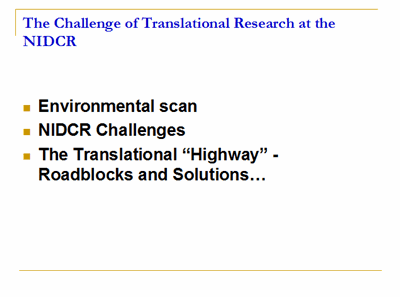 Well, good morning. It's really a great pleasure to start this conference off. What I propose to do this morning is to review with you an environmental scan, some of the challenges faced by NIDCR, and then talk about the metaphorical translational highway—not dwelling on the roadblocks, but perhaps suggesting some solutions. Well, good morning. It's really a great pleasure to start this conference off. What I propose to do this morning is to review with you an environmental scan, some of the challenges faced by NIDCR, and then talk about the metaphorical translational highway—not dwelling on the roadblocks, but perhaps suggesting some solutions. |
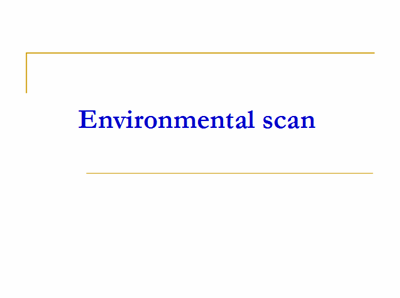
So, in terms of the environmental scan, I think you all appreciate the landscape that we all face together |
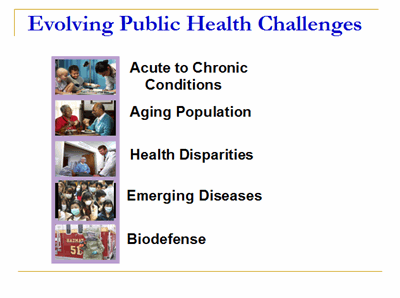 —one where the disease burden that we now face has shifted from acute diseases and conditions to those of chronicity. The "boomers" are turning 60—that's a very scary thought—I'll just leave it at that. Clearly, despite all of the extraordinary advances made in biomedical science, there still remain real health disparities. You cannot get through the day without hearing about something about some new, or emerging, or re-emerging disease. Particularly when it comes to this area of the country, issues of biodefense certainly weigh heavily. So, taken collectively, we need to put into context anything that we need to accomplish within these overarching challenges. —one where the disease burden that we now face has shifted from acute diseases and conditions to those of chronicity. The "boomers" are turning 60—that's a very scary thought—I'll just leave it at that. Clearly, despite all of the extraordinary advances made in biomedical science, there still remain real health disparities. You cannot get through the day without hearing about something about some new, or emerging, or re-emerging disease. Particularly when it comes to this area of the country, issues of biodefense certainly weigh heavily. So, taken collectively, we need to put into context anything that we need to accomplish within these overarching challenges.
|
Now, I think you will all agree that 20th century medicine was predicated on treating the disease when symptoms appeared or when normal function was lost, and in part this related to the fact that we did not understand the molecular and cellular events that underlie many diseases and conditions. The net result, of course, is tremendous expense both in terms of treatment and disability. If the system is not to collapse on itself in the 21st century, we need to intervene well before the symptoms even appear, thereby preserving normal function for as long as possible. And to do this, clearly we need to understand the preclinical molecular events, and detect patients at risk. Presumably that will provide a much more effective, fiscal solution for us.
|
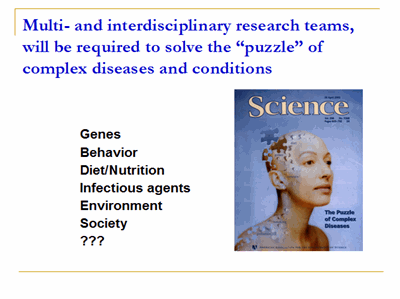 Eleni has already alluded to multi- and interdisciplinary research, and many of us feel that it is multi- and interdisciplinary research teams that will be required to solve what has been termed the puzzle of complex diseases and conditions. And by complex diseases, of course, we mean those diseases and conditions that result from an interplay between and among things such as genes and behavior, diet and nutrition, infectious agents, environment and society, and who knows what else. So, this is very, very complicated. Often when I use this slide, no one will ever ask it in the public session, but somebody will come up afterwards and say, "But what does this have to do with Dentistry?" Indeed, what I would argue is that virtually every disease that we deal with in dental, oral, and craniofacial health falls under this rubric. Eleni has already alluded to multi- and interdisciplinary research, and many of us feel that it is multi- and interdisciplinary research teams that will be required to solve what has been termed the puzzle of complex diseases and conditions. And by complex diseases, of course, we mean those diseases and conditions that result from an interplay between and among things such as genes and behavior, diet and nutrition, infectious agents, environment and society, and who knows what else. So, this is very, very complicated. Often when I use this slide, no one will ever ask it in the public session, but somebody will come up afterwards and say, "But what does this have to do with Dentistry?" Indeed, what I would argue is that virtually every disease that we deal with in dental, oral, and craniofacial health falls under this rubric. |
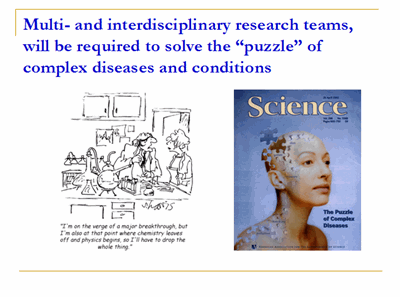 For those of you in the back who cannot read the caption, the cartoon reads: "I'm on the verge of a major breakthrough. But I'm also at the point where chemistry leaves off and physics begins. So, I'll have to drop the whole thing." At least this is the way I was brought up in science, too many years ago. We have to prevent that from ever happening again, and that's what this emphasis on multidisciplinary research teams is all about. For those of you in the back who cannot read the caption, the cartoon reads: "I'm on the verge of a major breakthrough. But I'm also at the point where chemistry leaves off and physics begins. So, I'll have to drop the whole thing." At least this is the way I was brought up in science, too many years ago. We have to prevent that from ever happening again, and that's what this emphasis on multidisciplinary research teams is all about. |
So, if you look at research teams of the future that will be required to do these types of interdisciplinary research, no doubt they will be composed of sociologists, engineers, physicists, mathematicians, economists, nurses, and dentists as well. It's going to be our collective challenge to figure out how to get all these folks to interact. The initial major barrier, of course, is that if you put all of these folks in a room together, it would be like a Tower of Babel. There would be a lot of talking, but no one would understand one other. So, a great deal of what we need to emphasize early on is some common platform, some common lexicon whereby these folks from these different fields are able to communicate effectively with one another.
|